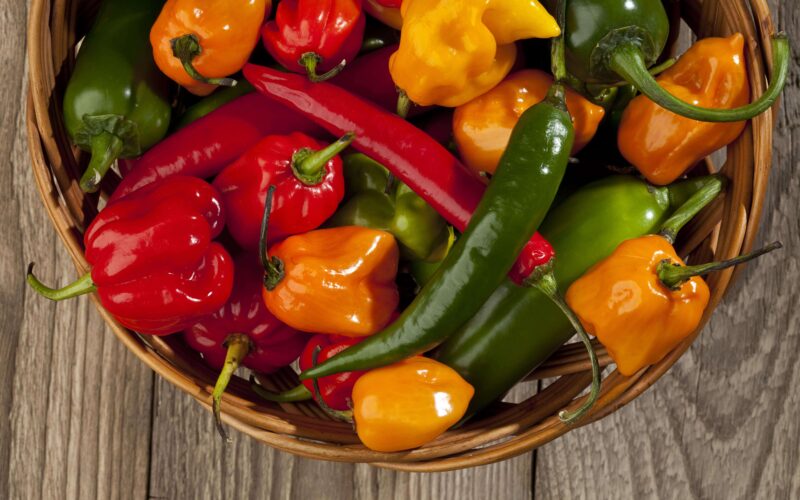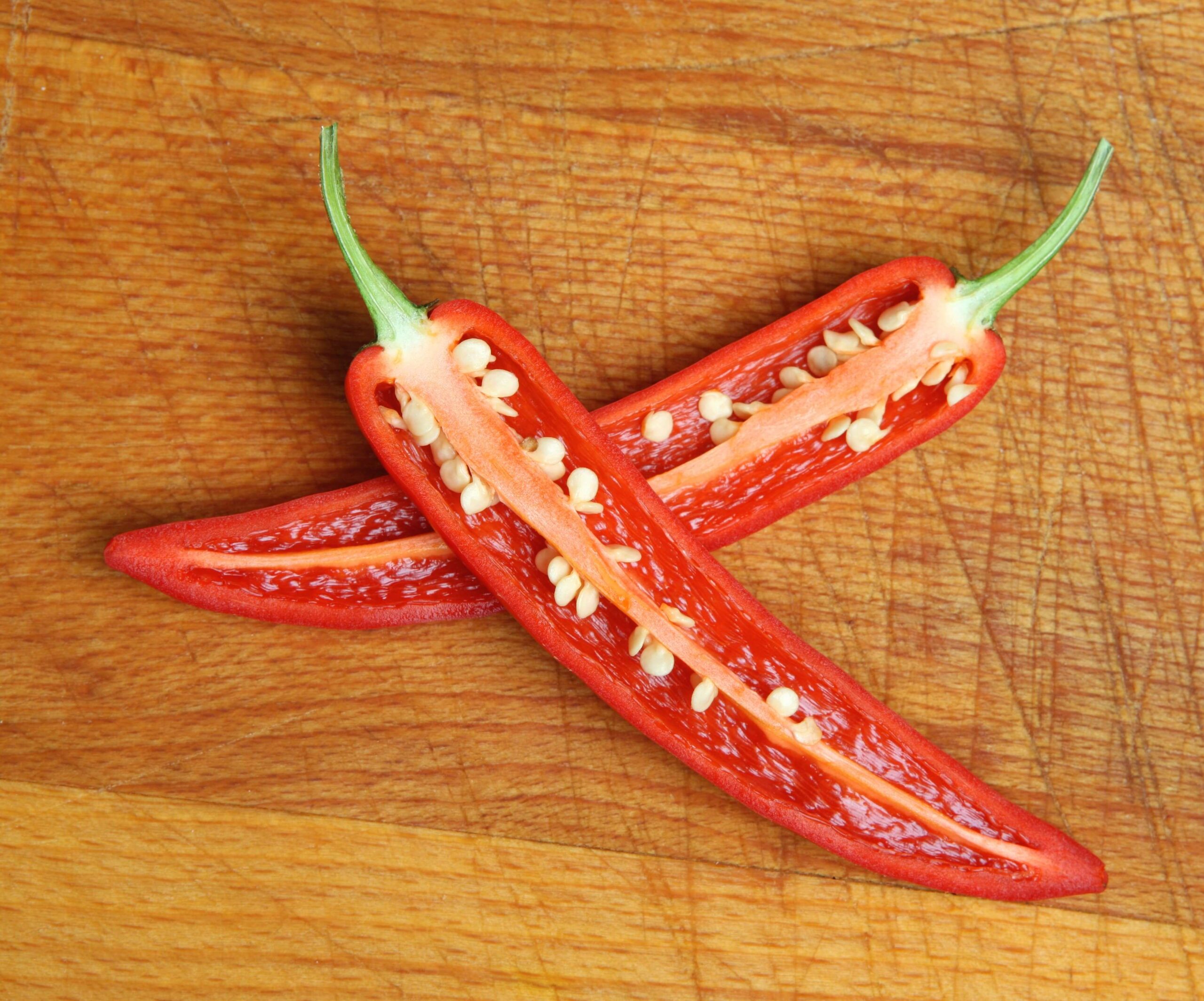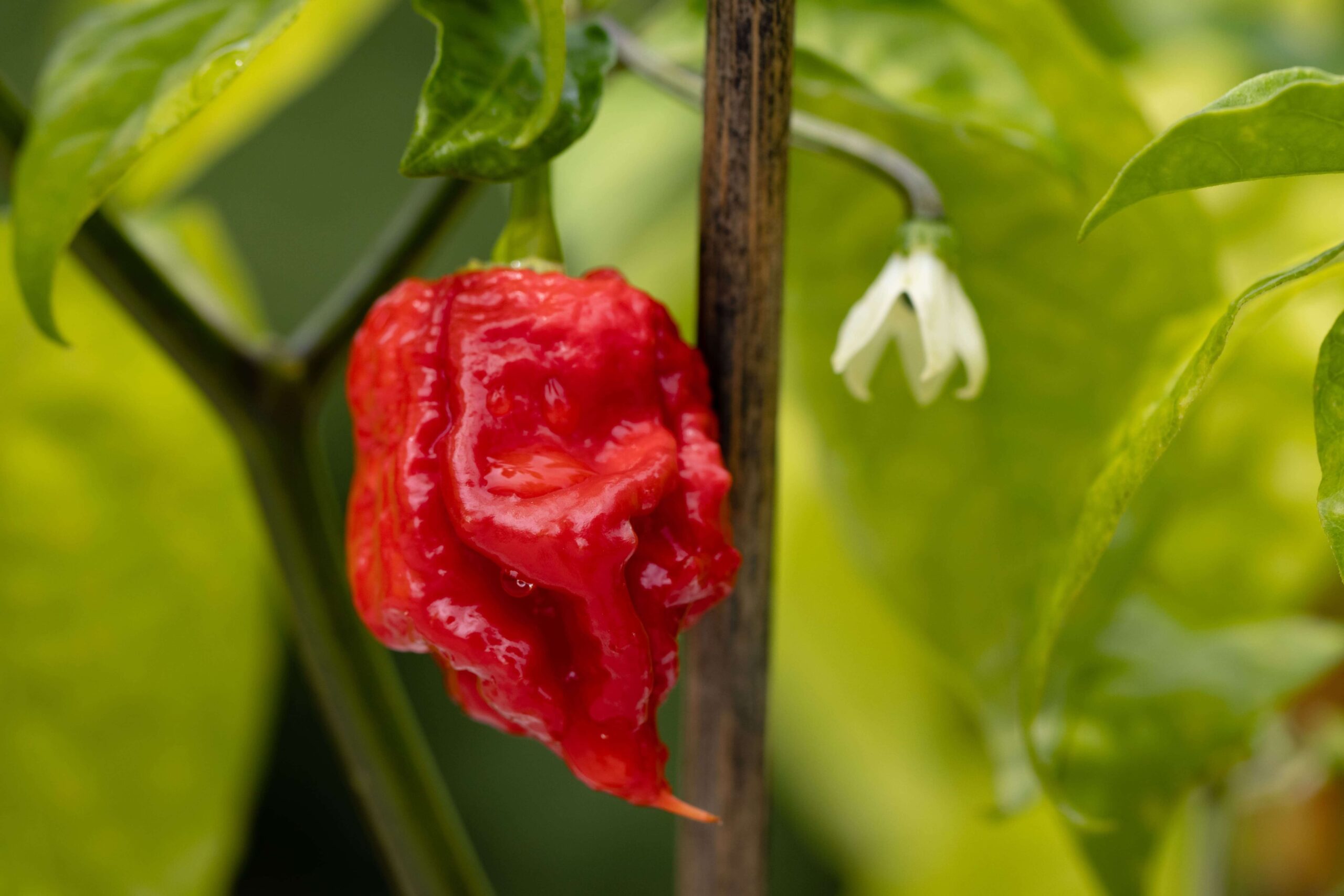Bring The Heat: A Guide to Chili Pepper Varieties

Nothing adds a little spice like a good, old-fashioned chili pepper. If cooking with hot peppers isn’t in your wheelhouse, we’re here to change that. Some of our favorite dishes know how to bring the heat. Whether you’re spice-obsessed or prefer it mild, our guide to chili pepper varieties is perfect for you.
What Makes Chili Peppers Hot?
As most people know, peppers can range from mild to extremely hot. What most people don’t realize is that their heat is a result of something called capsaicin. Capsaicin is a chemical compound mostly found in the white lining of the pepper, called the placenta or pith.
The burning feeling happens when capsaicin triggers the pain receptors in your mouth, which are located at nerve endings that also detect heat. This chemical reaction sends signals to your brain claiming that your mouth is on fire, and your body reacts accordingly. But don’t worry—chili peppers can’t cause any real tissue damage!
Similar to oil, capsaicin repels water. That’s why drinking water to soothe the burning feeling doesn’t work. It’s also why you need to be careful not to touch your mouth, eyes, or other sensitive parts of your body after handling a chili pepper—the oils will be transferred and the burning will spread.

Pepper Seeds
One of the biggest misconceptions about hot chili peppers is that the seeds are the spiciest part. While seeds tend to be coated in capsaicin, they don’t actually contain any of the compound themselves. In reality, the spiciest part of a chili pepper is the inner-white pith because it has the highest concentration of capsaicin.
Fun fact: Birds are immune to the burning effects of capsaicin, making them the perfect vessels for carrying pepper seeds.
Measuring Heat With The Scoville Scale
The Scoville scale measures the intensity of a chili pepper by the amount of capsaicin present. For a little history, it was invented in 1912 by an American pharmacist named Wilbur Scoville. He tested the heat by dissolving a dried pepper in alcohol to extract the capsaicinoids. Then he diluted it with water and had it tested by a panel of five experts.
In each round, he would dilute the pepper more and more until the burning sensation completely disappeared for at least three of the testers. A pepper’s Scoville rating is based on how much dilution was needed to reduce the heat.
The Scoville scale is recorded in Scoville Heat Units (SHU). The higher the SHU, the hotter the pepper. To put this all in perspective, if a pepper measures 10,000 SHU, that means it had to be diluted 10,000 times before it was no longer spicy.
As you can imagine, the Scoville scale is extremely subjective since it relies on the tolerance of the taste testers and the individual peppers used. Therefore, each type of chili pepper has a wide range of potential SHU values. Even those of the same variety can have different heat levels based on growing conditions and the pepper’s maturity.
Nowadays, we use a more scientific method for measuring the amount of capsaicin in a pepper called high-performance liquid chromatography. This technique helps reduce the subjectivity of Scoville’s method and is the standard used by the food industry.
Common Chili Pepper Varieties (And Their Scoville Rating)
Now that you understand the science behind the spice, we’ll talk about some of the most common kinds of chili peppers and their Scoville rating. For context, pure capsaicin clocks in at 15-16 million SHU.
Mild (0-2,500 SHU)
Bell Peppers: 0
- Sweet and mild, with a crunchy texture
- Used in salads, stuffed dishes, or eaten raw as a snack
Poblano Pepper: 1,000 – 2,000
- Mild with a rich, earthy flavor
- Often used in stuffed peppers, or roasted and added to sauces
Anaheim Pepper: 1,000 – 5,000
- Mild and slightly tangy
- Used for roasting, stuffing, or in salsas and sauces to add a mild heat
Medium (2,500 – 30,000 SHU)
Jalapeño Pepper: 2,500 – 8,000
- Moderately spicy
- Bright and fresh flavor
Serrano Pepper: 10,000 – 25,000
- Hot, bright, and crisp
- Used in hot salsas, marinades, and spicy dishes
Hot (30,000 – 100,000 SHU)
Cayenne Pepper: 25,000 – 50,000
- Hot and pungent, with a slight sweetness
- Often dried and ground to a powder to add heat to dishes
Thai Pepper: 50,000 – 100,000
- Very hot, with a fruity and intense spiciness
- Often used in Thai, Vietnamese, and other Southeast Asian dishes to add fiery heat
Extra Hot (100,000 – 500,000 SHU)
Habanero Pepper: 100,000 – 350,000
- Hot and fruity with a hint of sweetness
- Used in hot sauces and spicy marinades (used sparingly)
Extremely Hot (500,000+ SHU)
Ghost Pepper: 1 million
- Extremely hot, with a fruity and smoky flavor
- Used in hot sauces, chutneys, and spicy dishes to add a fiery kick (used sparingly)
Download our chili pepper varieties chart to explore the Scoville rating of other popular types!

What Is The Hottest Pepper In The World?
The answer isn’t as simple as you would think. The world of peppers is constantly changing, with new species and chili pepper varieties popping up constantly. Currently, the hottest pepper in the world is…
Pepper X
Developed by Ed Currie, Pepper X has an average of 2.69 million SHU and peaks at over 3 million. Its seeds have not been publicly released, so you cannot grow or taste it yourself.
The previous record-holder for the hottest pepper in the world was the Carolina Reaper, another Currie creation, coming in at an average of 1.64 million SHU and hitting a record of 2.2 million. It was named the world’s hottest pepper in 2013 and tested again in 2018, where it earned an even higher SHU, increasing by a whopping 71,000.
A cross between a ghost pepper and a red habanero, the Carolina Reaper was created for heat. But it’s not just spicy; it also has a surprising fruity flavor!
Creative Ways to Use Hot Chili Peppers in Your Cooking
How you use them in your cooking depends on the type of chili pepper, your spice tolerance, and your overall taste preference. Here are some ideas to get you started on your chili pepper journey!
- Salsa and guac
- Stuffed peppers
- Pepper poppers
- Roasted pepper sauce
- Pepper-infused oil
- Pepper jelly
- Homemade hot sauce
Explore more recipes or check out our online hot sauce and chili pepper selection.
Tips for Cooking With Chili Peppers
Cooking with different kinds of chili peppers can be challenging, so here are our tips to keep your cool while bringing the heat.
- Wear gloves. Since capsaicin is an oil-like compound, it will stick to your skin. Wearing protective gloves while handling chili peppers will keep your hands clean, especially if you have sensitive skin.
- Don’t touch your eyes. Be careful not to get the oils in your eyes or other sensitive areas while cooking.
- Less is more. Remember, you can always add more spice. When working with peppers higher on the Scoville scale, start with less than you think you need. Or start with a milder pepper and work your way up.
- Remove insides and seeds. If you need to cut the heat, remove the white insides and seeds for a milder flavor. But remember, it’s all up to you and your taste buds.
- Pair with other flavors. Chili peppers aren’t just hot—they often have a fruitiness to them. This makes them great for dishes like salsa and sauces, or you can add something sweet to pair with the spicy!
- Finish with lime. Since capsaicin is an alkaline molecule, balancing it with an acid helps neutralize the spice. Adding some lime or lemon juice to your dish could help relieve the pain.
- Have a backup plan. In case the heat is too much for you, here are some common products used to help with the burning feeling in your mouth:
- Dairy—the fat and oil will help dissolve the capsaicin, so always have a glass of milk or serving of yogurt on hand.
- Peanut butter—the oils in peanut butter will also help intercept capsaicin.
- Starch—bread and rice don’t dissolve capsaicin but act as a physical barrier and absorb the spice.
- Lemonade—any acidic food or drink will help neutralize the spice.
Ready to spice up your cooking? Find your nearest Stauffers of Kissel Hill and stock up on the different chili pepper varieties.
